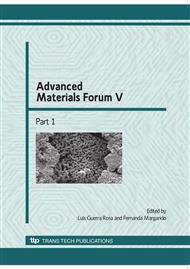p.26
p.31
p.36
p.41
p.47
p.54
p.60
p.68
p.76
Mechanical Behaviour of ZrO2-Bioglass Dental Ceramics under Cyclic Fatigue Loading
Abstract:
The cyclic fatigue life of 3mol%Y2O3-stabilized ZrO2 (3Y-TZP) ceramics doped with bioactive glass has been investigated. Samples of 3Y-TZP containing 3 or 5wt% of bioglass were sintered at 1300oC for 120 minutes. Sintered samples were characterized by relative density, XRD and SEM analysis. Mechanical properties of hardness and fracture toughness were determined using Vickers indentation method and Modulus of Rupture was determined by four-point bending testing. Furthermore, the reliability of the samples was estimated using Weibull statistic analysis. The cyclic fatigue life was estimated using four-point bending testing under frequency of 25Hz and stress ratio, R, of 0.1. Highly dense tetragonal ZrO2 samples were obtained after sintering and presented hardness of 10.5 and 11GPa, KIC of 6 and 7MPam1/2, bending strength of 320 and 450MPa and Weibull’ modulus of 6 and 7 for samples containing 5 or 3% of bioglass respectively. The fatigue behavior indicates that the increasing of stress level leads to decreasing of the number of cycles and the number of run-out specimens. Fatigue behavior was similar for the two compositions tested. Samples containing 3% of bioglass are more resistant (near 10%) to fatigue presenting cyclic fatigue life near to 250MPa while samples with 5% presented fatigue limit near to 220MPa.
Info:
Periodical:
Pages:
47-53
Citation:
Online since:
January 2010
Keywords:
Price:
Сopyright:
© 2010 Trans Tech Publications Ltd. All Rights Reserved
Share:
Citation:


